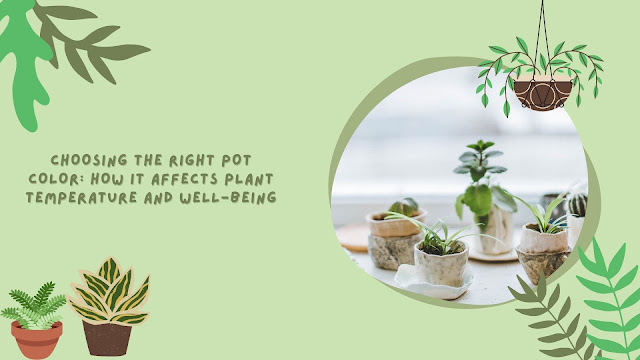Choosing the Right Pot Color: How It Affects Plant Temperature and Well-being

When selecting pots for your garden or indoor plants, the color of the pot is often overlooked in favor of size, material, and design. However, the color of your plant pots can play a crucial role in regulating soil temperature and, consequently, the health and growth of your plants. Here’s an in-depth look at how pot color affects these factors and how you can use this knowledge to enhance your gardening success.
The Influence of Pot Color on Soil Temperature
Pot color significantly impacts how much heat is absorbed or reflected, which affects the temperature of the soil. Here’s a breakdown of how different colors perform:
1. Dark-Colored Pots
Dark pots, such as those in black or dark brown, absorb more sunlight compared to lighter colors. This absorption results in higher soil temperatures, which can be beneficial for certain conditions:
Cool Climates: In cooler regions or during the colder months, dark pots can help keep the soil warmer, which promotes root growth and extends the growing season.
Winter Gardening: For winter gardening or early spring, dark pots can provide the extra warmth needed for plants to thrive.
However, there are potential downsides:
Hot Weather: In hot climates, dark pots can lead to excessively high soil temperatures, potentially causing heat stress and harming plant roots. Regular monitoring and watering are essential to prevent overheating.
2. Light-Colored Pots
Light-colored pots, such as white, beige, or light pastels, reflect more sunlight and absorb less heat. This reflection helps keep the soil cooler, which has its advantages:
Hot Climates: In regions with high temperatures, light-colored pots can prevent soil from becoming too hot, reducing the risk of heat stress and keeping plant roots healthy.
Summer Months: During summer, these pots help maintain a more stable soil temperature, which can be particularly beneficial for delicate or moisture-loving plants.
However, light-colored pots may also have some drawbacks:
Cool Climates: In cooler weather, they might not retain enough warmth, which can slow down growth and potentially affect plant health. Adding insulation or using supplemental heating might be necessary.
Practical Considerations for Pot Color
1. Plant Type and Needs
Different plants have varying requirements for temperature and moisture:
Succulents and Cacti: These plants thrive in warmer conditions, so dark-colored pots can be beneficial in cooler climates.
Tropical Plants: These plants often prefer cooler soil conditions, making light-colored pots a better choice in hot climates.
2. Location and Climate
Consider where you place your plants and the local climate:
Outdoor Gardens: For gardens exposed to full sun, light-colored pots can help mitigate excessive heat. For shaded areas, dark pots may provide necessary warmth.
Indoor Spaces: In indoor settings, where temperature fluctuations are less extreme, pot color can be less critical but still plays a role in maintaining consistent soil conditions.
3. Aesthetic and Practical Balance
While the functional aspect of pot color is important, aesthetics also play a role in your overall gardening experience:
Matching Décor: Choose pot colors that complement your garden or interior design while keeping in mind their impact on plant health.
Maintenance: Dark pots may show dirt and water stains more readily, while light pots might require more frequent cleaning to maintain their appearance.
Conclusion
The color of your plant pots is more than just a design choice; it can significantly influence soil temperature and plant health. By understanding how different colors absorb or reflect heat, you can select pots that better suit your climate and the specific needs of your plants. Whether you choose dark or light colors, ensure that you monitor soil conditions and adjust your care routine accordingly. With the right pot color, you can create an optimal environment for your plants to grow and thrive.



Comments
Post a Comment